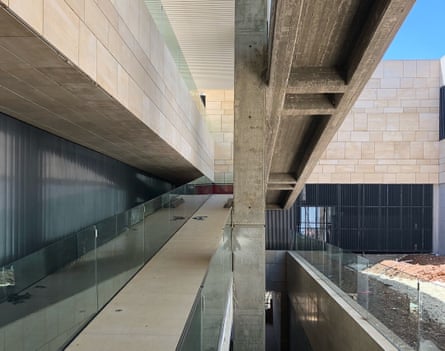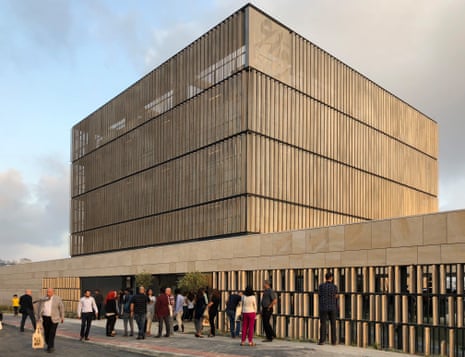A dark, grey cube shimmers on a hillside on the edge of Ramallah, standing apart from the confetti of bright white apartment blocks that sprawl across the surrounding slopes. Rising from a series of limestone terraces above a scrubby valley of olive trees, this metallic box is the new $21m (£15.95m) home for the AM Qattan Foundation, an arts centre that its founders hope will stand as a “beacon of culture” in the occupied West Bank.
“It is more than just an arts centre,” says Omar Al-Qattan, the Beirut-born, British-educated chairman of the foundation. “We hope it might be a modest microcosm of urban public life, something that Palestinian cities lack.”
It is no small ambition, but then the Qattan Foundation has always dreamed big. Founded in 1993 by Omar’s father, Abdel Mohsin Al-Qattan, a Palestinian refugee who made a fortune in the Gulf construction industry, it now employs more than 100 people in the West Bank and Gaza, running educational outreach programmes and public activities with a focus on science, drama and the arts. Its efforts have always been dispersed across numerous sites, and Al-Qattan’s dying wish was to see everything brought together in one place, with a gallery, library, theatre, artists’ residencies and studios for dance and art, along with one of the first public plazas in the city.
Look at a map of Ramallah and you will see several intersections deceptively marked as “squares”, which turn out to be traffic-choked roundabouts. Visitors to the new complex will enjoy the rare treat of standing on a car-free limestone plaza, where fountains will soon spurt, with a cafe and views of the rolling valley beyond, all shielded from the street by a long, perforated stone wall. The building’s multilevel terraces teemed with excited families at the public opening on 28 June, when more than 1,500 people showed up to explore the facilities.
It is the work of Seville-based Donaire Arquitectos, who were chosen following an invited competition of small, young practices. They have brought a refined Andalusian sensibility to the arid site. “We are Spanish, so we had to bring a plaza and a bar,” jokes Juan Pedro Donaire, who relocated his team here for the last three years to supervise the work closely. “It has been years of fighting to achieve anything close to the standards we wanted. There are defects, but it is the best we could do while building under (Israeli) occupation.”

They struggled with the lack of a skilled workforce – he says the best builders work across the border, where Israeli firms pay double or triple local wages – and endured endless delays, with imported materials held up by Israeli customs. The library shelves were mysteriously detained for three months, while a container of light fixtures a sheet of bulletproof glass needed for the gallery space to be able accept precious loans have yet to arrive.
“We are used to the daily harassment,” says Al-Qattan, who received permission last year to visit his foundation’s Gaza children’s centre, after waiting for a decade, “but this is an absurd abuse of power.”
Considering the constraints, the architects have pulled off an impressive feat and achieved a rare level of precision. There are some bodged details, but the result is far superior to most buildings in ramshackle towns of the West Bank.
Greeting the street with a long, stone wall, it has the air of a corporate compound from the outside, and there is a defensive, citadel quality to its imposing presence on the hill. Once inside, you arrive in an oasis of calm. A shallow ramp leads you down past sunken gardens to the main gallery space (the largest in the city at 410 sq m) and down again to a small theatre, lined with Weetabix-like acoustic panels, and spaces for dance and painting, all of which open out on to a terrace looking over the valley. The perforated metal cube of the library and foundation offices emerges from this limestone plinth of cultural functions, standing as a glass box clothed with a pleated skin of louvres, giving a silvery corduroy finish. Glinting in the sun, it is alien enough to stand out, while doing so with modesty. As Donaire puts it: “We cannot be Zaha Hadid here. We had to be vernacular, but at the same time offer a surprise and bring something of international quality.”
The shimmering continues inside, where a wall of aluminium, perforated with a traditional textile pattern, lines the oak-floored atrium. It is an airy space, flooded with light from circular openings in the roof, in a nod to Finnish architect Alvar Aalto’s Viipuri library. The two-floor library, teaching spaces and offices above offer spectacular views, while fresh air flows across the floors, helping to earn the building silver award Palestinian Higher Green Building Council – the second such project to be certified, following the Palestinian Museum last year. It couldn’t get a higher award, the architects say, because the required services simply aren’t in place. Great piles of construction waste spill down the hillside, awaiting collection.

The fraught context is highlighted in the building’s opening exhibition, Subcontracted Nations. Once again struggling with what could be imported, the show nonetheless brings together an impressive range of politically charged work, from Bisan Abu-Eisheh’s speculative designs for Palestinian banknotes, to Alexandra Sophia Handal’s study of how expropriated Palestinian houses in West Jerusalem are repackaged for the Israeli market as “Arab style”. It is self-critical, too: anyone who has dealt with Middle Eastern bureaucracy will sympathise with the message behind Notarised by Majdi Hadid, a gigantic rubber stamp bearing the emblem of the Palestinian National Authority that greets visitors at the entrance.
It is an ominous presence, and a reminder of the precarious situation. When you are waiting by the trash heap for a taxi, it is easy to question the viability of this gleaming new facility in a suburb not served by public transport. Al-Qattan says the foundation is in talks with the municipality about introducing a shared taxi route, or its own shuttle service, and he is optimistic it will soon feel more connected, given the rate of Ramallah’s growth.
“But it is part of a much wider problem,” he says. “The events of 1948, when Palestinians were expelled from Jaffa, Jerusalem, Haifa, Acre, Tiberias, had a profound impact on the society’s relationship to the built environment. Because of the squeeze of the occupation, places like Ramallah were subject to this crazy wave of totally artificial immigration. There’s a kind of resentment and anger reflected in how they build and organise themselves. There is a temporariness to everything, informed by growing up in refugee camps.”
He says the next big challenge is to think in a new way about Palestinian urban life and rebuild it properly, something that this new complex hopes to point towards. “We want this to be a place where strangers can meet, where ideas can be exchanged, where you can just come and be anonymous. A public space in every sense of the word.”
